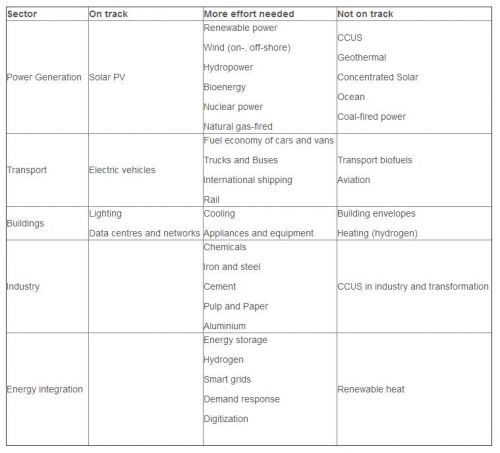本文转自GCCSI(全球碳捕集与封存研究院)发布的题为“Urgent action required for "off track" CCUS: Recent IEA study”的报道。
日期:2018.06.05
原文链接:https://www.globalccsinstitute.com/insights/authors/IanHavercroft/2018/06/05/urgent-action-required-track-ccus-recent-iea-study?author=NDM3MQ%3D%3D&author2=Mjg5ODg%3D
The International Energy Agency (IEA) has released its latest assessment of the status of energy technologies and sectors. The Tracking Clean Energy Progress (TCEP) study assesses global progress against the Agency’s Sustainable Development Scenario and the proposed transformation of the energy sector. Under this Scenario the rise of average global temperatures is limited to “well below 2°C”, as specified in the Paris Agreement, universal energy access is increased, and air pollution is significantly lowered.
国际能源署(IEA)发布了对能源技术和行业状况的最新评估。 跟踪清洁能源进展(TCEP)研究评估了全球进展与该机构的可持续发展设想,以及拟议的能源部门转型评估。 在这种情况下,全球平均气温的上升限于“远低于2°C”,正如“巴黎协定”所规定的那样,通用能源通道增加,空气污染明显降低。
CCUS is “off track”
CCUS是“偏离轨道”
The IEA has highlighted limited progress in both CCUS on power and industry and has categorised CCUS as “off track”.
IEA强调,CCUS在电力和工业方面的进展有限,并将CCUS归类为“偏离轨道”。
The Sustainable Development Scenario requires the capture and storage of 350 million tonnes of CO2 per year (Mtpa) from the power sector in 2030. Currently, the capture rate is only 2.4 Mtpa.
可持续发展方案要求2030年从电力部门捕获和储存3.5亿吨二氧化碳(Mtpa)。目前捕获率仅为每年240万吨。
In the industry and transformation sector, the IEA has described the CCUS current capture rate of 28 Mtpa as “woefully off-track for the SDS target” with a required rate at 500 Mtpa in 2030 and 1600 Mtpa in 2040.
在工业和转型领域,国际能源署已经将CCUS目前的2800万吨捕集率描述为“非常不符合SDS目标”,2030年需要的利率为5亿吨,2040年为1600万吨。
In both instances, a significant increase in deployment will be required to meet the ambitious targets set for CCUS.
在这两种情况下,都需要显着增加部署才能达到为CCUS设定的雄心勃勃的目标。
Image source: International Energy Agency
图片来源:国际能源署
Key points for CCUS
CCUS要点
The Institute has identified the following key points regarding the progress of CCUS in the TCEP study.
该研究所在TCEP研究中确定了关于CCUS进展的以下要点。
Positive
Several CCUS projects are now operating in both industry and power
Technological innovation is occurring and new processes are being trialled in industrial applications
CCUS projects are being developed in many parts of the world
There is considerable opportunity for cost reductions from “next-of-a-kind” projects
There are early signs of improvements in the policy environment (e.g. 45Q tax credits in the US)
积极方面:
1. 几个CCUS项目现已在工业和电力两方面开展
2. 技术革新正在发生,工业应用中正在试用新工艺
3. 世界上许多地方正在开发CCUS项目
4. “独一无二”的项目有很大的降低成本的机会
5. 政策环境有改善的早期迹象(例如,美国的45Q税收抵免)
Negative
Only two CCUS projects are operating in the power sector and only one additional industrial CCUS project has entered operation since 2017
Limited volumes of CO2 are being stored by operational projects and at a scale which is too small to meet future mitigation requirements
Insufficient number of projects under development or in the early planning stages
Greater improvements to both policy and financial support for the technology will be required
消极方面:
1. 电力行业目前只有两个CCUS项目,2017年以来只有一个新增的产业CCUS项目投产
2. 作业项目储存的二氧化碳量有限,规模太小,无法满足未来的减排要求
3. 在发展中或在早期规划阶段的项目数量不足
4. 需要对这项技术的政策和财政支持作出更大的改进
We cannot meet the objectives of the Paris Agreement without CCUS
没有CCUS,我们无法实现《巴黎协定》的目标
The IEA has continually emphasised that to meet the Paris Agreement’s targets:
国际能源机构不断强调,为了实现巴黎协议的目标:
1. 所有的技术都是需要的。
2. 国家和国际气候变化政策需要支持所有技术。
The TCEP reinforces these statements – 2 degrees will not be met unless all technologies achieve their deployment goals.
TCEP强化了这些说法——除非所有技术都实现其部署目标,否则不能达到2摄氏度。
How does CCUS compare to the other technologies?
CCUS与其他技术相比如何?
The TCEP concludes that 34 of 38 technologies are “not on track” or “require more effort”. Only solar PV, electric vehicles, lighting, as well as data centres and networks are on track to meet deployment targets.
TCEP得出的结论是,38项技术中有34项“没有进展”或“需要付出更多努力”。只有太阳能光伏发电、电动汽车、照明设备以及数据中心和网络能够实现部署目标。

What can be done?可以做什么?
Predictable policy and confidence to invest drives deployment
可预测的政策和投资信心推动部署
We can attribute solar PV’s status to the significant scale of deployment, which has brought down the costs of solar PV units. Feed-in-tariffs are the main driver of solar PV deployment and have been in- place in many countries for some time. The IEA highlights China’s recent feed-in tariffs, as a catalyst for more widespread solar PV deployment.
我们可以将太阳能光伏的地位归因于大规模的部署,这降低了太阳能光伏设备的成本。上网电价是太阳能光伏发电的主要推动力,并且在很多国家已经有一段时间了。国际能源署强调中国近期的上网电价,作为更广泛的太阳能光伏部署的催化剂。
It is clear from the solar PV example, that supportive policy leads to greater uptake and ultimately lowers the costs of deployment. To meet targets and avoid climate change, all technologies will require that same policy confidence currently afforded to solar PV. For CCUS, increased policy confidence will engender an investment environment conducive to large-scale infrastructure construction and long asset life.
从太阳能光伏的例子可以清楚地看出,支持性政策导致了更多的应用并最终降低了部署成本。为了实现目标并避免气候变化,所有的技术都需要太阳能光伏目前的政策信心。对于CCUS来说,政策信心的增强将产生一个有利于大规模基础设施建设和长期资产寿命的投资环境。
The IEA also highlights the impact of private-sector efforts, which have resulted in emissions reductions in industrial applications, through fuel switching, energy efficiency, and recycling. For CCUS in industrial applications, it is likely that the private sector will play a critical role.
国际能源署还强调了私营部门的努力所产生的影响,这些努力通过燃料转换,能源效率和循环利用,导致了工业应用的减排。对于工业应用中的CCUS,私营部门很可能会发挥关键作用。